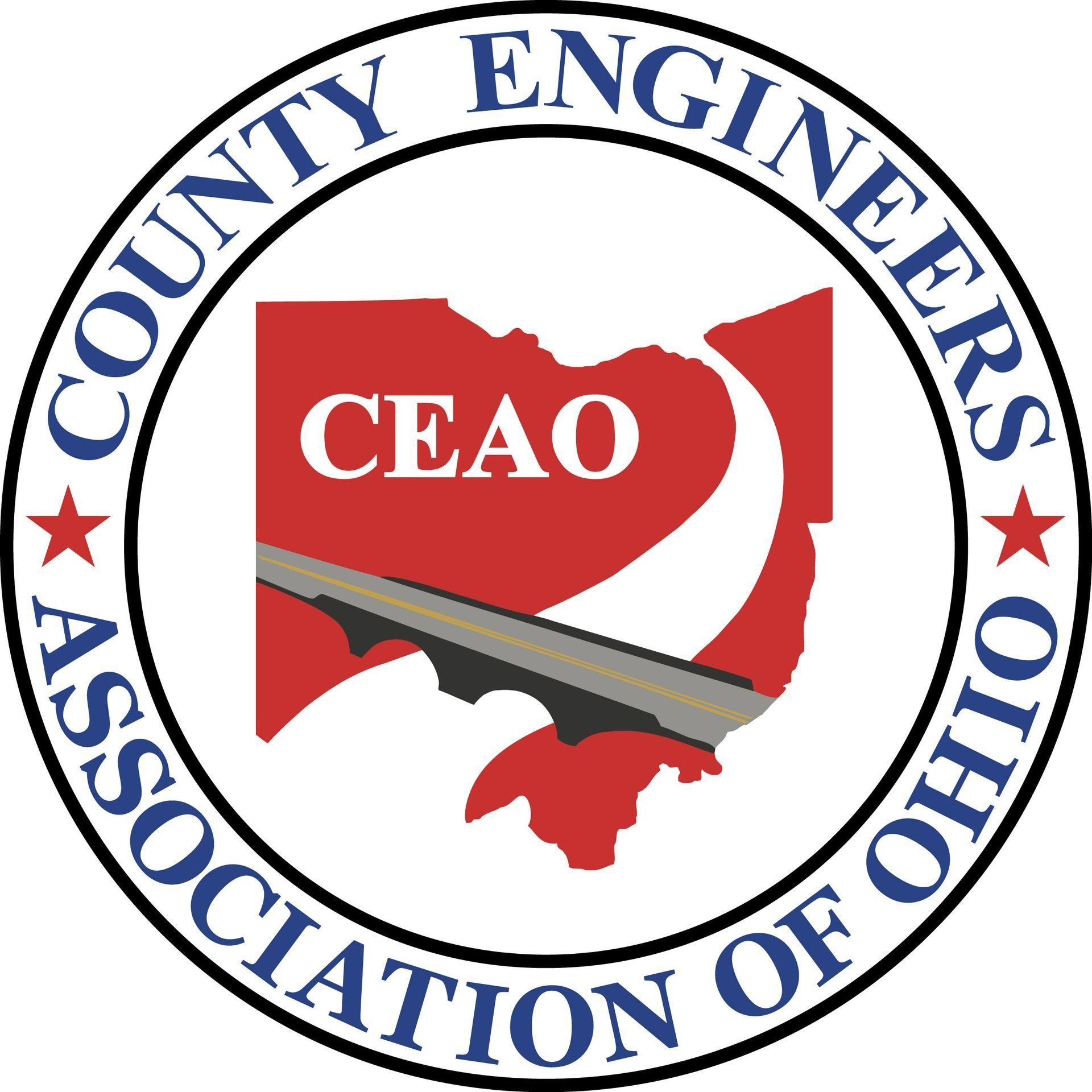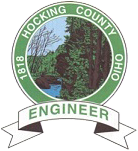Ohio County Engineers - Since 1803
Ohio's County Engineer
Today, the elected County Engineer is sworn to “perform for the county all duties authorized or declared by law to be done by a civil engineer or surveyor.” Although specifically exempt from engineering duties affecting public buildings, the County Engineer is the engineer for all public improvements under the authority of the board of commissioners within and for the county. For example, in Ohio, county engineers are responsible for more than 27,000 bridges, 29,000 miles of highways, and managing budgets between $2,500,000 and $40,000,000 annually.
As a group, Ohio’s county engineers are recognized leaders in the nation because of their professionalism and innovations relating to the maintenance of highways and bridges. Ohio’s requirement for professional licensing in both engineering and surveying, the fact that the position is elected, and the fact that the gasoline taxes and license plate fees are dedicated to the repair and maintenance of highways and bridges by the state’s constitution allow these elected professionals to utilize the scarce resources in an efficient and professional manner. Almost 20% of Ohio’s county engineers hold advanced or additional degrees. As a group, they represent over 1,700 years of public works experience. This averages to 20 years per engineer. On average they have held licenses as professional engineers for 25 years and have held licenses as professional surveyors for 21 years.
Responsibilities of Today’s County Engineer
There are four district highway systems in Ohio. The Ohio Department of Transportation (ODOT) is responsible for the 19,000-mile State Highway System. The Township Trustees collectively oversee the maintenance of the Township Highway System with its 39,000 miles of roads. Municipalities maintain the streets and alleys within their boundaries, which together would span over 21,000 miles. The 29,000-mile County Highway System is, of course, the responsibility of Ohio’s 88 County Engineers. The County Engineer works with the County Commissioners and Township Trustees to carry out a wide variety of obligations.
- County Highways: The County Engineer is responsible for the maintenance, repair, widening, resurfacing, and (re)construction of pavements and bridges in the County Highway System. Maintenance duties include traffic control, safety projects, mowing, and snow removal.
- Township Highways: The County Engineer serves as an engineering advisor to the Township Trustees for the maintenance, widening, and repair of their highways.
- Bridges: The County Engineer is fully responsible for the bridges on both the County and the Township Highway Systems and may also be charged with the upkeep of bridges within municipalities, including some that are part of the State Highway System. The County Engineer performs the annual inspection and evaluation of the condition and load-carrying capacity of each bridge. The statutes regulating this duty require a uniform method of procedure and record-keeping.
The County Engineer participates in county and regional planning commissions and provides tax map drafting services for the county. In unincorporated areas, the County Engineer may also be involved in the establishment and maintenance of petitioned and assessed ditches, sidewalks, and even county airports. The County Engineer may also serve as County Sanitary Engineer, working with the County Commissioners to supervise the construction of sewer and water lines. The approval and operation of landfills and incinerators may also be a function of the County Engineer’s office.
History of the County Engineer in Ohio
The office of County Engineer evolved from the important role played by the County Surveyor in the first decades of Ohio’s statehood.
As early as 1785, Ohio served as a “laboratory” for the development of the Public Lands rectangular survey system, and well into the 1800s, the County Surveyor was charged with the tremendous task of clarifying land titles and boundaries. After 1820, a movement for “internal improvements” swept through the state, and county surveyors became increasingly involved in transportation-related projects, specifically in the development of canals and roads. By the late 19th century, the major duty of the county surveyor was the building and maintenance of roads, bridges, and drainage ditches.
The office of County Surveyor was established by the first General Assembly following the admission of Ohio to the Union in 1803. Whenever a new county was created, the County Surveyor, Recorder, Prosecuting Attorney, and Clerk were appointed by the legislature. County surveyors were paid only a per diem wage ($5.00 in the late 1800s) for those days when they were actually employed.
In 1831, the legislature voted to make the office elective because of the increased responsibilities it entailed. The law stated that a county surveyor would serve a term of three years, “if he so long qualified.” Legislation passed in 1915 established a salary and conferred on the County Surveyor the title of “Resident Engineer for the State Highway Department.” In 1928, the term of office was lengthened from three years to four. Then on August 30, 1935, the title was changed to “County Engineer.”
Today, only persons who hold registration certificates from the State of Ohio as a “Registered Professional Engineer” and “Registered Professional Surveyor” may hold the office of County Engineer.
Tax Mapping
Ohio law mandates that the county engineer create and organize the tax maps of his community. These tax maps must be updated on a daily basis to reflect changes in property ownership. This responsibility entails creating and maintaining a detailed inventory of every parcel of land in the county. A map must be drawn for every parcel of property in the county, and this map must be to scale. The County Auditor’s office uses these detailed tax maps as its official record for property tax purposes.
Where the Money Comes From
The several activities of the County Engineer are financed from various sources. The major responsibility, the upkeep of roads and bridges, is primarily financed by highway user fees such as motor vehicle fuel taxes and registration fees. Supplemental funds (voted bond issues and levies, as well as fines) are available for specific highway improvement purposes.
Fuel taxes earmarked for highway purposes are levied at the state and federal levels of government. State revenues are distributed for use in the state, county, township, and municipal highway systems by means of statutory formulas. The amount of the tax varies depending on legislative action. Also, some of the monies distributed to the states from federal funds are passed on to local governments on a project-by-project basis.
The income from state motor vehicle registration fees (after state administrative costs are deducted) is returned to the local government units on the basis of a statutory formula. Currently the distribution percentages are 71% for counties, 24% for municipalities, and 5% for townships. County, municipal and township government agencies have the authority to also levy their own motor vehicle registration fee in the form of an additional tax of up to $20.00 (in $5.00 increments). The amounts levied vary from county to county according to highway improvement needs and the enactment procedure of the three levels of local government. The revenues received must be used for highway purposes.
CEAO
The County Engineers Association of Ohio (CEAO) had its beginnings in 1879, when a group of Ohio’s surveyors (the predecessors of today’s County Engineers) met in Columbus to discuss ways of meeting professional needs. In 1880, the Association of County Surveyors of Ohio held its first official meeting and pledged to “bring the interests that [they] represent[ed] into proper position before the public; obtain a better recognition of [their] services; and above all things, secure for [themselves] a higher professional education and protection of the public from the evils of empiricism.”
In 1940, after sixty years of changes in name and scope, the County Engineers Association of Ohio came into being. Its purpose is to “raise the technical and non-technical standards of service rendered to the general public by the County Engineer and his employees through the establishment of a central point for reference and group discussion of mutual problems.”

Dean Ringle, Executive Director
The County Engineers Association of Ohio
1103 Schrock Road Suite 202
Columbus, OH 43229
PH. (614) 221-0707


